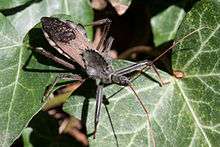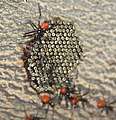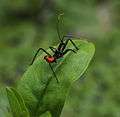Wheel bug
The wheel bug (Arilus cristatus) is a species of large assassin bug in the family Reduviidae (literally, "hangnail").[1][2] The species is one of the largest terrestrial true bugs in North America, reaching up to 1.5 inches (38 mm) in length in their adult stage.[3] They are sexually dimorphic, in that males are somewhat smaller than the females. A characteristic structure is the wheel-shaped pronotal armor. Wheel bugs prey on caterpillars and beetles, such as Japanese beetles, the cabbage worm, orange dogs, tent caterpillars, and the Mexican bean beetle,[4] all of which they pierce with their beak to inject salivary fluids that dissolve soft tissue.[5] Wheel bugs are most active in daylight, though they may engage in predatory behaviors at night in areas illuminated by lights.[6] Because most of their prey are pests, wheel bugs are considered beneficial.
| Wheel bug | |
|---|---|
 | |
| Scientific classification | |
| Kingdom: | Animalia |
| Phylum: | Arthropoda |
| Class: | Insecta |
| Order: | Hemiptera |
| Family: | Reduviidae |
| Subfamily: | Harpactorinae |
| Tribe: | Harpactorini |
| Genus: | Arilus |
| Species: | A. cristatus |
| Binomial name | |
| Arilus cristatus | |
They are camouflaged and very shy, residing in leafy areas and hiding whenever possible.[7] Specifically, habitats of the wheel bug include sunflowers, goldenrod, cotton, trunks of locust trees, and various fruit and tree groves.[4] They have membranous wings, allowing for clumsy, noisy flight which can easily be mistaken for the flight of a large grasshopper. The adult is gray to brownish gray in color and black shortly after molting, but the nymphs (which do not yet have the wheel-shaped structure) have bright red or orange abdomens. It was described in 1763 by Carl Linnaeus. Despite the prevalence of the wheel bug in many habitats, the information compiled concerning the species is haphazard and incomplete.[4]
Description
The wheel bug has a characteristic dorsal crest, shaped like a wheel or cog. It moves and flies slowly, and in flight produces a noisy buzzing sound. As with other assassin bugs, its proboscis arises from the anterior end of its long, tubular head and unfolds forward when feeding.
It possesses two scent glands (red-orange in color) that can be ejected from its abdomen, usually in reaction to being disturbed. The scent produced by it is not as powerful as that produced by stink bugs, but is still strong enough to be detected by humans.
Wheel bugs exhibit armored forewings and membranous hind wings which allow the wheel bug to take flight.[8] As a result of its inability to move swiftly, wheel bugs rely heavily upon camouflage, the effect of their bite, or the production of unpleasant odors in order to avoid predation.[9]
Distribution
Wheel bugs are most common in eastern Canada and the United States, and their range extends into Mexico and Guatemala.[1][4] Among the four species of Arilus, a western hemisphere genus, only A. cristatus is found in the United States.[3]
Behavior
Wheel bugs initiate predation by gripping and pinning their prey with their front legs.[9] The bug plunges its beak into its victim before injecting it with enzymes, paralyzing it and dissolving its insides, and proceeds to drain the resulting fluids.
The wheel bug is also noted to be very aggressive in the wild, and cannibalistic behaviors between them have been noted; for example, nymphs may prey on one another and the female may feed on the male after mating is concluded.
Additionally, like many reduviids, the species is capable of producing audible sound by rubbing the tip of its proboscis in a groove under its thorax. The purpose of this sound is unknown and may serve as a means of communication between members of the species.[8]
Reproduction
The reproductive cycle of the wheel bug initiates in autumn. After mating, the female will lay 40-200 small, brown, cylindrical eggs, and eventually die. Females lay eggs on trees, bushes, twigs, and other objects.[6] Secreted glue serves as an adhesive which maintains the cluster formation of the eggs. The eggs will hatch in the following spring into eight millimeter long red nymphs, which will undergo 5 molts until they reach the adult stage the following summer.
After the nymphs hatch, the average length of each molt is roughly 18.8 days, though the interval of the 5th and final molt prior to the adult stage is the longest. Eggs generally hatch in the beginning of May and finally mature into adults by July. Overall, it takes roughly 94 days for nymphs to reach maturity. However, the phenology of this life cycle varies based upon the climate which the population occupies. For instance, communities in warm climates may not overwinter as eggs.[4]
In a laboratory test conducted at Southern Illinois University in 1997 and 1998, research revealed that the species’ eggs may be attacked by parasitic wasps, such as Ooencyrtus johnsoni.[10] Of the 12 clusters of eggs monitored in the lab, 10 were ravaged by parasites which prevented the eggs from hatching normally.[4]
Wheel bugs are predatory immediately upon hatching, but the distinctive wheel unique to the species derives only after the bug reaches the adult stage following the final molt.[1]
Ecological significance
Wheel bugs are highly regarded by organic gardeners because they consume a variety of insects and their presence indicates a healthy, pesticide-free ecosystem. "They're the lion or the eagle of your food web," Dr. Michael J. Raupp, an entomologist at the University of Maryland, notes. "They sit on top. When you have these big, ferocious predators in your landscape, that tells me that this is a very healthy landscape, because all these other levels in your food web are intact."[11]
Though wheel bugs are a welcome agent of pest control, they also prey on several ecologically beneficial species, such as lady beetles and honey bees.[6]
Interactions with humans
The species is generally indifferent concerning the presence and interruption of humans. Although evidence suggests that wheel bugs can seemingly be domesticated in controlled environments, if provoked or mishandled, they may attack in an act of defense. As a cautionary warning, the bite of a wheel bug is generally considered to be of greater severity in terms of the level and duration of pain than the sting of common insects such as wasps.[6] The resulting wound is documented to be extremely painful, lasting, and lingering, accompanied by an unceasing numbness which can persist for days. These effects can be avoided by handling the docile insect with gloves. The bite is not considered highly venomous, so is not serious in the short term.[1][12] Furthermore, the vicinity of the injury is known to become heated and irritated. A white crust sometimes forms around the wound during the healing process, though it eventually deteriorates, leaving the small puncture wound visible. Discomfort may persist for 2 weeks and up to 6 months in some cases. However the latter timeline is frequently attributed to allergic reactions or recurrent infections of the original wound.[6]
Gallery
 Wheel bug nymphs and eggs
Wheel bug nymphs and eggs Nymph closeup
Nymph closeup.png) Wheel bug on pool skimmer, Arkansas
Wheel bug on pool skimmer, Arkansas Adult found in Fort Worth, Texas
Adult found in Fort Worth, Texas Wheel bug consuming a Japanese beetle
Wheel bug consuming a Japanese beetle Older nymph walking atop a fence
Older nymph walking atop a fence
References
- Johnson, Bill. "The Wheel Bug". Horticulture. 111.2.
- Columbia Electronic Encyclopedia. MAS Ultra. 2016 – via RaptorSearch.
- "Featured Creatures: common name: wheel bug". University of Florida IFAS.
- Hagerty, A.M.; McPherson, J.E. (2000). "Life History and Laboratory Rearing of Arilus Cristatus (Heteroptera: Reduviidae) in Southern Illinois". The Florida Entomologist. doi:10.2307/3496229.
- Creary, Scott. "Cristatus, Arilus". Organic Gardening. 61.5.
- Mead, F.W. (1974). "The Wheel Bug, Arilus Cristatus". Entomology Circular.
- Wheel Bug - Scientific Name, Classification, Taxonomy, North American Reach and Size
- Thomas, Bob (November 11, 2009). "Wheel Bug, Arilus cristatus". Loyola Center for Environmental Communication: College of Arts and Sciences. Loyola University New Orleans. Retrieved November 2, 2016.
- Hawkinson, Candice. "Wheel Bug". Beneficials in the Garden. Galveston County Master Gardeners. Retrieved December 5, 2016.
- Wanted Dead or Alive (No, Just Dead), Anne Raver, New York Times, November 27, 2013
- Creary, Scott (July 9, 2014). "Wheel Bug, Arilus cristatus". Rodale's Organic Life. Rodale's Organic Life. Retrieved October 12, 2016.